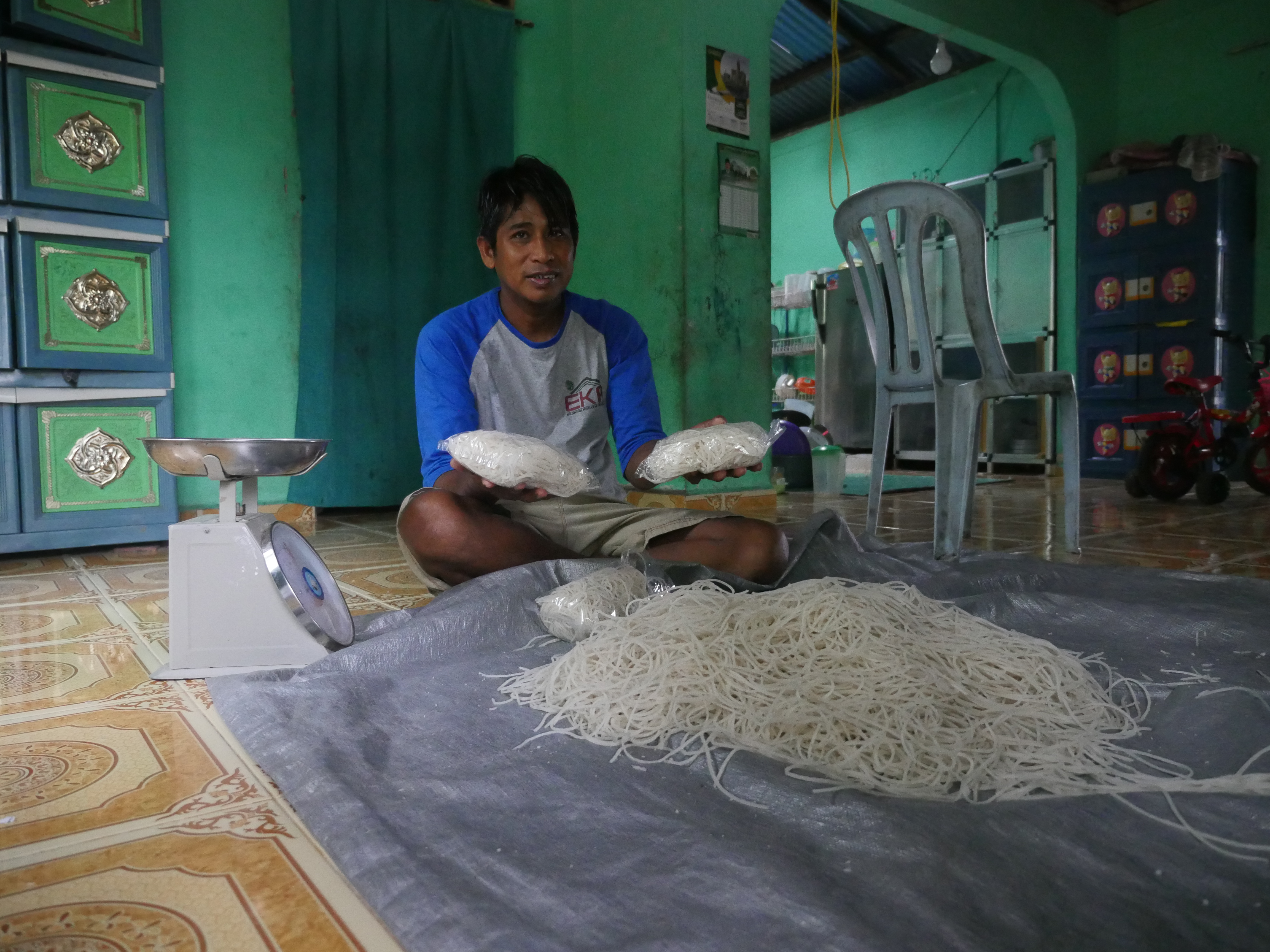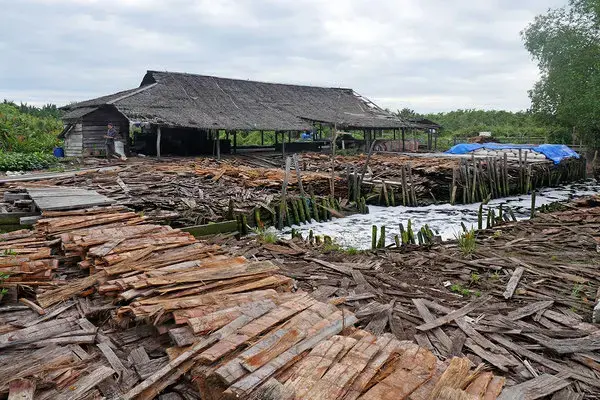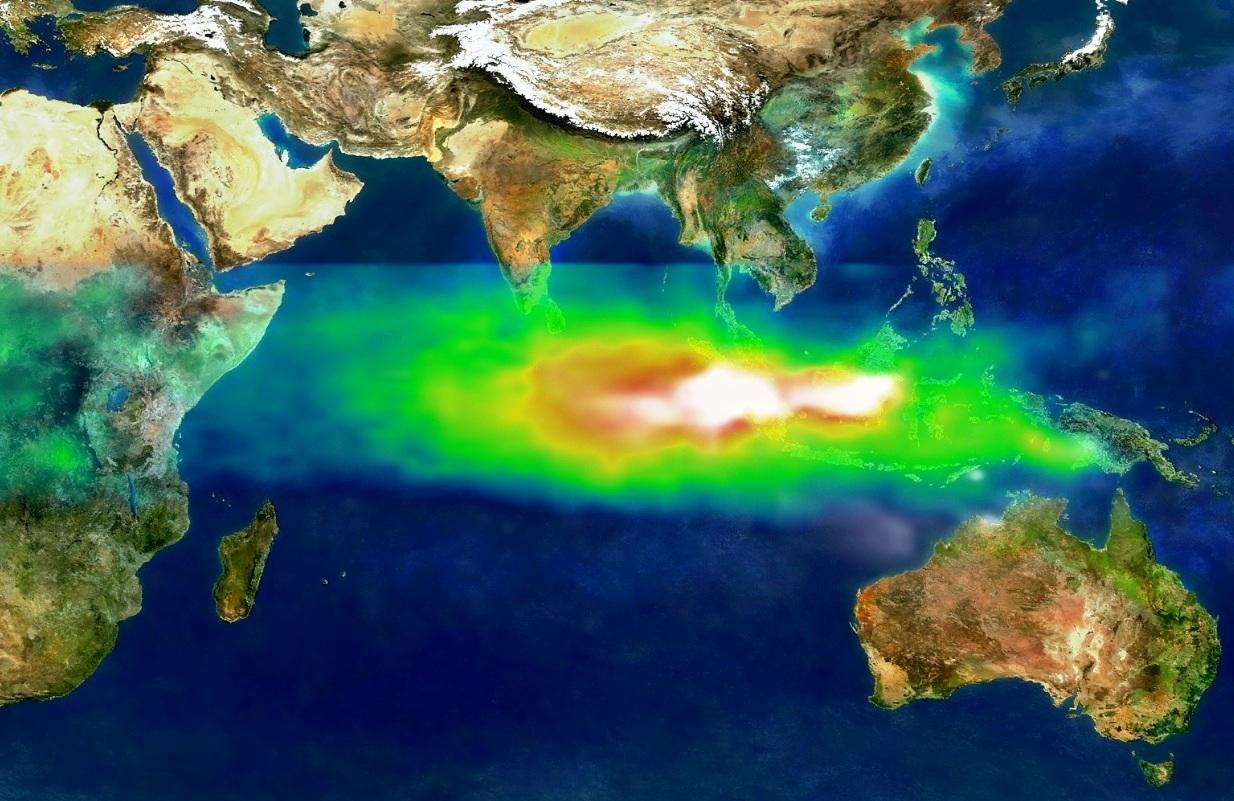
A picket fence encloses a single sago palm in Sungai Tohor, a village of 1,300 on the coast of Sumatra. A billboard to the right gives title to the bushy tree: the Jokowi Sago Monument. Jokowi is the nickname of Indonesia’s president, Joko Widodo. The tree was planted in his honor when he visited in 2014.
Abdul Manan, the farmer and entrepreneur who drives me to the sago shrine on the back of his beat-up motorcycle, says it’s no surprise that villagers are proud of this palm. Sago is the most important crop in this part of Indonesia.
“This is like villagers’ savings,” he says, “to pay for the children to go to school, to middle school, to university.”
Mr. Manan himself owns a 12-acre stand of sago and a mill for grinding up its pulp, an edible starch. He produces packets of coconut-flavored balls of roasted sago and bags of sago pasta.
Just before President Widodo’s visit, wildfires had swept through Sungai Tohor and other parts of the province of Riau. Fires have devastated Borneo—an island that Indonesia shares with Malaysia and Brunei—and Sumatra for decades. The incessant blazes reduce oil palm and acacia plantations to ashes and incinerate dwindling patches of natural forest, home to orangutans and pygmy rhinos. Fires have exposed millions of Indonesians, Singaporeans, and Malaysians to toxic air pollution.
Indonesia’s wildfires also release vast amounts of carbon dioxide (CO₂), contributing to global warming, embarrassing the Indonesian government, and impeding international efforts to slow climate change. Further conversion of forest to fire-prone industrial plantations “must be stopped,” President Widodo declared to an entourage of Indonesian journalists during his stay at Sungai Tohor. Give the land to family farmers instead, the president said, “so they can use it to plant sago.” Mr. Manan, the sort of small-time grower he was talking about, listened at the edge of the crowd.
President Widodo’s pronouncements may have helped to create a recent surge in sago production. It certainly raised the visibility of the cultivation of swamp-adapted trees, a fire-resistant form of farming dubbed paludiculture. If widely adopted, paludiculture could make Indonesia’s land less prone to fires, protecting the health of residents and cutting off a globally significant source of CO₂ emissions. It would also protect the long-term viability of farming on Indonesia’s coastal plains, where fires have been a persistent problem.
The dryland illusion
Hans Joosten, an ecology professor at Germany’s University of Greifswald, says Indonesia’s fire troubles can be traced, literally, to the dawn of Western civilization.
“The Western way of agriculture has as its cradle the Fertile Crescent in the Middle East,” he says, an arid region with infrequent rainfall.
The ancestral agriculturalists of European civilization domesticated plants and animals and developed tools and techniques for dry conditions. Europeans later adopted the “dryland philosophy,” spreading it, along with the empires, around the world. After conquests, they favored adopting dryland crops—potatoes and corn, for example—even where farmers also grew wetland plants.
Professor Joosten says this history led to “the illusion that productive land has to be dry,” even though “wetlands belong to the most productive areas in the world.”
Even rice—a seeming exception, farmed in flooded fields—requires dry soil for part of the year. It won’t grow in perpetually soggy ground.
Wetlands are common around the world, yet they’re seldom farmed before being drained. Most farms in the Netherlands, where Professor Joosten grew up, were natural wetlands before settlers “reclaimed” the land by drying it with its legendary network of dikes and canals.
Until the past several decades, waterlogged peatland covered in dense jungle completely rimmed Sumatra and Kalimantan—Indonesia’s portion of Borneo—a Florida-size area. Peatlands are wetlands in which dead trees’ roots rot exceedingly slowly. The undecayed plant matter builds up year after year, creating deep, spongy deposits.
Only indigenous tribes—who hunted monkeys and indigenous pigs there—paid much attention to Indonesia’s peatlands. The soggy jungle floor defied mechanized equipment, blocking industrial logging. None of Indonesia’s major crops tolerate their perpetually high water.
Peatlands store huge amounts of carbon—up to 100 times as much as the wood in trunks and branches of the trees that grow on them. Indonesia’s peatlands, which have accumulated for 15,000 years, are 60 feet deep in places.
In contrast to other wetlands, peatlands become highly flammable when drained. In Ireland and other parts of the world, dried peat heats homes and fuels power plants. Because of their immense volume, Indonesia’s peatlands generate huge amounts of CO₂ and continental-scale clouds of toxic pollution when they catch fire.
But the virgin peatlands rarely burned. Peatland jungles are quite fireproof. Mr. Manan, the sago farmer, shows me why.
“Roll up your pants,” he says, tucking his into the cuffs of rubber boots. Springy soil squishes noisily underfoot.
A few steps into the woods, he brushes away a tangle of palm fronds, revealing a PVC pipe sticking a few inches above the ground. He pulls out a long, straight dowel that, like a car’s dipstick, measures the position of the forest’s water table. Reddish droplets—tannin and other decay products in peat-color groundwater—drip off the end, showing that the water table is only a couple feet below the surface. Even during Sumatra’s dry season, Mr. Manan says, the combination of groundwater below and rainwater above keeps the soil sopping wet.

A fiery ‘wake-up call’
The tranquil preindustrial state of the peatlands ended in the 1990s. Timber companies began running out of easy-to-harvest upland trees and turned their attention to the less-accessible swamps. Between 1990 and 2015, woodcutters harvested nearly three-quarters of the peatland forests on Sumatra and Kalimantan, an area half the size of the United Kingdom. The cleared ground was too soggy for dryland crops. But companies with government concessions excavated thousands of miles of canals, dehydrating the soil. Then they planted oil palm, to satisfy the exploding global demand for biofuels and alternatives to hydrogenated oil, and fast-growing acacia trees, a source of paper pulp. Family farmers, with little capital and no relevant expertise, rarely made use of these cleared swamps. They’d always carved their garden plots from dryland parcels layered with fertile mineral sediments on riverbanks.
The corporate plantation growers sowed the saplings of their own destruction, however. For years experts warned that the plantations’ drained peat was dangerously flammable. They also said that the desiccated wetlands would subside. In its natural state, peat is up to 95 percent water. Once dehydrated, it compacts and slumps year after year. Eventually the surface sinks below sea level. Unless protected by dikes and continuously pumped—methods employed in the Netherlands but impossibly expensive in Indonesia—the land becomes inundated with salt water and infertile.
In late 1997 Indonesia suffered a scorching drought. As predicted, the peatlands burst into flames. The whole country seemed to burn. One estimate suggests that between 7 and 34 percent of Indonesia’s peatlands ignited. Scientists piecing together what happened later calculated that the fires released 3 to 10 billion tons CO₂ in several months, possibly as much as the entire United States and all of Europe produce in a year.
The fires were “a wake-up call,” says Wim Giesen, a Dutch consultant with Euroconsult Mott MacDonald, who has advised the Indonesian government how to respond. Still, Indonesia continued draining peatlands carelessly for two more decades.
Conflagrations now recur nearly every dry season, turning Indonesia into the third-highest source of climate-warming CO₂.
In 2015, the smoke was so thick “you couldn’t see the house across the street,” recalls Laura Graham, a biologist at the Borneo Orangutan Survival Foundation. Dr. Graham works in Palangkaraya, a city carved from peatlands in Kalimantan, where she monitors efforts to restore damaged forest. Pollution from 2015’s fires killed 100,000 people in Indonesia, Malaysia, and Singapore. The World Bank has concluded that it cost Indonesia $16 billion in economic damage.
“The good thing about the 2015 fires,” says Dr. Graham, “was that people finally stood up and said ‘We can’t keep doing this.’ ”
Nurturing a paradigm shift
In January 2016, President Widodo created the Peatland Restoration Agency, an arm of the government for coordinating efforts to rewet desiccated swamps. The goal is to dam and fill in canals across 2 million hectares (nearly 8,000 square miles) of peatland by 2020.
What’s needed is “a paradigm shift in thinking, going from crops that require drainage to crops that require rewetting,” says Marcel Silvius, the Indonesia representative of the Global Green Growth Institute, an environmental group operated by 30 member countries. Many peatland experts want the government to raise water tables to natural conditions, where water bubbled up above the surface of some land during the wet season and dropped to just below otherwise. But this would end oil palm and acacia production on a territory larger than Belgium. The government has split the difference, requiring that water tables be raised slightly but not so high as to endanger industrial plantations. Still, a shift from dryland agriculture to paludiculture has begun.
After touring Sungai Tohor’s sago groves and pulping mills, Mr. Manan drives home, showers, and changes into a fresh sarong, a traditional batik shirt, and a black velvet peci, the fez-like hat Indonesian men wear on formal occasions. Seated on the floor of his modest wood-frame house, he serves a dinner of hot tea and fresh sago pasta smothered in greens and peanut sauce.
“Delicious,” he says in English.
Later that evening, a small cargo ship pulls up to a nearby dock. A crew of roustabouts loads it with 15 tons of sago paste from Mr. Manan’s mill for dealers in Singapore, 70 miles across the Malacca Strait.
Sago, a staple for centuries in New Guinea and Borneo, is by far Indonesia’s most important paludiculture crop. Farmers—mostly small-timers such as Mr. Manan—produce about 50,000 tons of it a year, an amount that has tripled since 2013. In addition to being used to make sago pasta, it’s used in baked goods such as cookies and cakes.
“There’s potentially a huge market for it,” says Mr. Giesen, the Dutch consultant. He says that for paludiculture to gain widespread acceptance, more wetlands crops with proven markets must be demonstrated.
“You don’t want people too dependent on one or two products,” he says.
Five years ago, Mr. Giesen, a botanist by training, compiled a list of 1,500 plants with known uses that grow in Indonesia’s peatland forests. He winnowed this down to 80 plants that have or have had “major economic importance.” The short list includes the trees jelutong, a source of natural rubber; galam, which produces a medicinal oil in its leaves, flowers favored by honeybees, and sturdy construction timber; and tengkawang, which produces quantities of nuts containing cocoa-butter-like fat.
Any of these plants have potential to replace swaths of existing plantations of oil palm and acacia. But in most cases the existing market for their products is limited or nonexistent.
They’ll “need nurturing,” says Mr. Giesen.
For instance, food and cosmetic manufacturers already satisfied with cocoa butter would have to be induced to consider tengkawang nut butter. Natural chewing gum makers would have to be persuaded to replace Mexican chicle for jelutong's rubbery sap.
Moreover, Mr. Giesen’s plants haven’t undergone domestication that could increase their economic potential. Professor Joosten, who coined the term paludiculture in 1998, points out that the productivity of dryland crops such as corn has multiplied a thousandfold over the native species from which they emerged. Tractor combines, pesticides, storage containers, and shipping equipment have been engineered for decades or longer to lower the cost of bringing today’s top crops to market.
“The entire value chain has been optimized,” he says. In contrast, “We’re in the early Neolithic of paludiculture.”
On the front lines of the battle to rewet Indonesia’s peatlands is Hesti Tata, a forester who promotes paludiculture for the Ministry of Environment and Forestry. Like Ray Kinsella, who turns a corn field into a baseball diamond in “Field of Dreams,” it’s her job to tell family farmers that the if they plant wetland trees such as jelutong, demand will come.
It’s not always an easy sell. Farmers are not used to working soggy fields, and they fear there will be no buyer when the saplings she offers them mature. Sometimes Ms. Tata worries that her advice might lead them astray. The government might have to ban dryland farming on peatlands for paludiculture to take off, she says. Otherwise, “there will be no significant increase in Indonesia.” With so much of Indonesia’s peat going up in smoke each year and adding to global warming, we might all be worse off for it.
Support for this reporting was made possible by the Rainforest Journalism Fund, in association with the Pulitzer Center.






